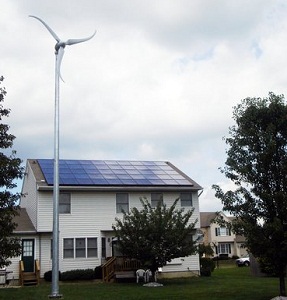Solar trumps wind in Washington pilot project
 A pilot project by Inland Power and Light Co. in Spokane, Wash., tested home-sized wind and solar power systems over a period of more than a year. The result—the photovoltaic-powered system trounced the wind turbine system, producing more than five times the amount of electricity over the period.
A pilot project by Inland Power and Light Co. in Spokane, Wash., tested home-sized wind and solar power systems over a period of more than a year. The result—the photovoltaic-powered system trounced the wind turbine system, producing more than five times the amount of electricity over the period.
The cooperative electric utility commenced the study in response to customers’ inquiries about which renewable energy is best for them, said Richard Damiano, chief engineer of Inland.
“This little project is purely a demonstration project for our members,” he said. Every year the utility receives roughly 50 to 60 inquiries from customers interested in installing renewable energy but aren’t sure which is best. To answer their questions, the utility decided to test both technologies.
The utility chose comparably sized systems.
“The solar panels are 2.24 kilowatts, and the wind turbine is 2.4 kilowatts at full wind,” said Damiano. “They were nominally the same nameplate capacity and nominally the same installed cost.”
Each system cost between $22,000 to $24,000 to purchase and install, prior to any tax rebates or other incentives, according to Damiano.
Despite the similar name-plate capacities, the solar by far outperformed the wind turbine, according to an informative pamphlet produced by Inland.
The pamphlet said the photovoltaic system produced 2,600 kilowatt hours—14.4 percent of an average home’s annual electric needs—during a one-year period. The wind turbine produced 525 kilowatt hours—2.9 percent of an average home’s annual needs—during the same period.
The pamphlet assumed that each system cost $30,000 (presumably, accounting for loan costs). At that cost, the solar system supplied electricity to a home at 10 times the cost of the power supplied by Inland.
The wind turbine supplied electricity at 50 times the cost of power supplied by Inland.
However, the prices don’t include the effects of tax rebates and other incentives.
Federal tax incentives would cut the cost of both by 30 percent, and power produced by the systems and put on the grid would be reimbursed at a premium of at least 18 cents per kilowatt hour, more if the equipment was made in Washington state, Damiano said.
While Damiano acknowledged that in the tests solar bested wind, he said the choice still is up to the customer.
“We’re just letting the data speak for itself,” he said. “We can’t help the customer with what do they want to do. We know that wind turbines take a little more maintenance. But we also know that solar isn’t right for every site.”
Image courtesy of NREL.



